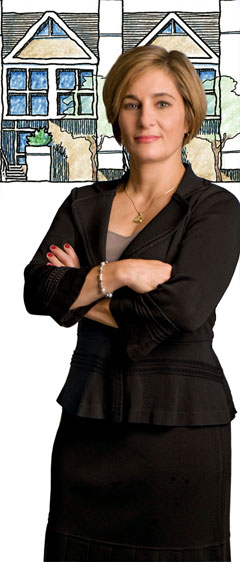 Debra Schwartz '88
Debra Schwartz '88
Director of Program-Related Investments, John D. and Catherine T. MacArthur Foundation
Impact investing is not a grant. There has to be some expectation of financial return, whether it's through a loan, equity investment or guarantee. But we're talking about a financial instrument where the social return is intentional. That's what distinguishes it from other areas of "social investing."
An impact investment is intended to create a positive social impact in addition to a positive financial return. It doesn't have to be a market rate of return, although for many people that's what's important. But if you do the kind of impact investing that I do, you can't seek a market rate of return. In fact, it's not allowed under the IRS tax code definition of a program-related investment, or PRI.
At the MacArthur Foundation, I oversee a $300-million PRI portfolio of below-market loans and investments that support economic development and affordable housing organizations in the U.S. I also co-lead a $150-million national initiative, Window of Opportunity: Preserving Affordable Rental Housing.
In the U.S., there is a giant need for development finance. Overseas, development finance is generally thought of as microcredit. In the U.S., it's mostly thought of as community development financial institutions, or CDFIs. Some of them focus on individuals and provide things like alternatives to payday lending, bank accounts and remittance accounts for immigrants that are not abusive in their fee structures. Some of them focus on small businesses, helping bring credit to businesses in low-income neighborhoods or businesses owned by minorities and women. They also support affordable housing, which has been the biggest area of my own personal work for the past 16 years.
There are about 800 of these institutions in the U.S. and they control about $30 billion in assets. At MacArthur, we invest in these intermediaries, but we put money in that is patient, so we plan an exit of 10 years instead of five or fewer. It's also cheaper — our loans are usually 1 to 3 percent.
Since we're not allowed to get a market rate of return on these types of investments, that allows us to be more flexible. We can give these institutions a cushion so that when an insurance company or a pension fund wants to invest, that investor can get a market rate of return and have enough risk mitigation. We're essentially the shock absorber in the middle, the missing piece that we call the "but for" money — meaning, but for our piece, they couldn't bring in the rest of the money. That's the power of our particular brand of impact investing.
When I came to Kellogg, I had already worked in the nonprofit sector for several years, mostly in the human services field. Although "social enterprise" was not yet a familiar term to business school students, I was eager to learn how social-purpose organizations earned, raised and managed their money. This curiosity was answered when a case taught by Professor Don Haider introduced me to the world of public finance. As an investment banker, I gained skills that have proved invaluable to my current work in deal management, structuring, credit analysis, risk mitigation and more.


